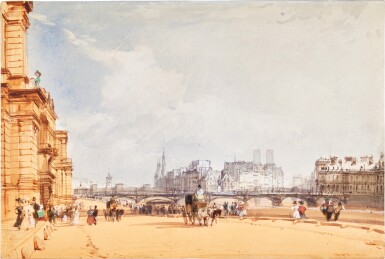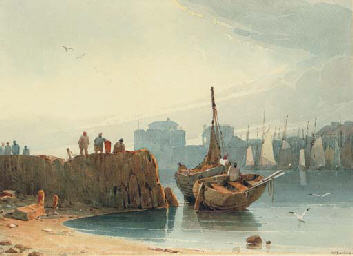Property from the Estate of Paul KasminRichard Parkes BoningtonArnold 1801 - 1828 LondonThe Count of Palatino in the costume of a Palikar oil on canvascanvas: 15 1/4 by 9 1/4 in.; 38.7 by 23.5 cm. framed: 22 by 16 1/2 in.; 55.9 by 41.9 cm. ProvenanceBonington sale, London, Sotheby's, 29 June 1829, lot 119 (as Studies of Grecian Costumes, two Figures on one canvas); Lord Charles Townshend (acquired from the above); By whom sold, London, Christie's, 11 April 1835, possibly lot 13 (as A Greek Chief. Full of character'; or lot 14, as 'The Companion Sketch); Hume, on behalf of William Beckford (acquired from the above); Webb sale, Paillet, C.P. Bonnefons, Paris, 24 May 1837, lot 28; H. A. J. Munro of Novar, by 1843; With Arthur Tooth & Sons, London, by 1952; With Galerie Alfred Daber, Paris, by 1954; Estate of Mr H.G.Th.Crone, by whom sold, London, Christie's, 11 December 2018, lot 60; There acquired by Paul Kasmin. LiteratureM. Pointon, The Bonington Circle: English Watercolour and Anglo-French Landscape 1790-1855, Brighton 1985, p. 93; P. Noon, Richard Parkes Bonington the complete paintings, New Haven and London 2008, no. 397, p. 426, reproduced. ExhibitedWintherthur, Kunstmuseum Winterthur, Europaische Maeister, June - July 1955, no. 16; Nottingham, Nottingham Castle Museum, R.P. Bonington Exhibition, April 10 - May 22, 1965, no. 289.Catalogue noteDemetrius de Palatiano (1794–1849), a member of a prominent family from Corfu, was according to the family tradition an enfant terrible. He is described in family records as unstable and flighty, said to have narrowly escaped being beheaded while in the service of the tyrant Ali Pasha, the local Ottoman ruler. He travelled widely throughout Europe, in Albania, the Ionian islands, Italy, Germany and England. Always the grand seigneur, he claimed in a letter to his sister that Maximilian, King of Bavaria, with whom he is said to have been on friendly terms, invested him with the title of Count. Though research in the Commonwealth and Bavaria archives have not been able to confirm this, Demetrius used the title freely in official documents, styling himself as the ‘Honourable Count Demetrius de Palatiano’. In late 1825, on his way to Corfu from England, he passed through Paris, where he posed for Delacroix’s Portrait de M. le Compte P. en costume de souliote. Exhibited at he 1827 Salon, the portrait is now only known through a copy in the Cleveland Museum of Art, yet numerous other studies of the Count by Delacroix and other artists have survived, including the present work. In the winter of 1825-1816, Bonington worked in Delacroix’s studio and, influenced by the French Romantic painter, he turned to genre and history painting. They worked closely together, manifesting a strong colouristic emphasis, sharing models and compositions. Dr. Pointon notes that ‘the most complete evidence of common subject matter and a very similar approach is to be found in the sketches that Delacroix and Bonington made for their portraits of Count Demetrius Palatiano in the costume of a Palikar’. Demetius is portrayed wearing the uniform of a Suliot, consisting of a long, white skirt, or "foustanella", gold-worked cloak, crimson velvet gold laced jacket and a waist-coat, silver mounted pistols and daggers. The Suliots were Greek/Albanian Christians who had fled from the repression of Ali Pasha when he became governor of Jannina in 1822, and who later fought courageously during the Greek War of Independence. The Greek War of Independence was a source of great interest for the rest of Europe and the exotic costumes of Greek soldiers, also known as Suliots or Palikari, became a popular subject matter amongst artists. If from a pictorial point of view, it may have been the costume that most attracted Delacroix and Bonington to Count de Palatiano, his colorful and extravagant personality must have also had a strong appeal at a period when the memory of Byron deeply influenced French Romantic Art. Byron posed in th
Property from the Estate of Paul KasminRichard Parkes BoningtonArnold 1801 - 1828 LondonThe Count of Palatino in the costume of a Palikar oil on canvascanvas: 15 1/4 by 9 1/4 in.; 38.7 by 23.5 cm. framed: 22 by 16 1/2 in.; 55.9 by 41.9 cm. ProvenanceBonington sale, London, Sotheby's, 29 June 1829, lot 119 (as Studies of Grecian Costumes, two Figures on one canvas); Lord Charles Townshend (acquired from the above); By whom sold, London, Christie's, 11 April 1835, possibly lot 13 (as A Greek Chief. Full of character'; or lot 14, as 'The Companion Sketch); Hume, on behalf of William Beckford (acquired from the above); Webb sale, Paillet, C.P. Bonnefons, Paris, 24 May 1837, lot 28; H. A. J. Munro of Novar, by 1843; With Arthur Tooth & Sons, London, by 1952; With Galerie Alfred Daber, Paris, by 1954; Estate of Mr H.G.Th.Crone, by whom sold, London, Christie's, 11 December 2018, lot 60; There acquired by Paul Kasmin. LiteratureM. Pointon, The Bonington Circle: English Watercolour and Anglo-French Landscape 1790-1855, Brighton 1985, p. 93; P. Noon, Richard Parkes Bonington the complete paintings, New Haven and London 2008, no. 397, p. 426, reproduced. ExhibitedWintherthur, Kunstmuseum Winterthur, Europaische Maeister, June - July 1955, no. 16; Nottingham, Nottingham Castle Museum, R.P. Bonington Exhibition, April 10 - May 22, 1965, no. 289.Catalogue noteDemetrius de Palatiano (1794–1849), a member of a prominent family from Corfu, was according to the family tradition an enfant terrible. He is described in family records as unstable and flighty, said to have narrowly escaped being beheaded while in the service of the tyrant Ali Pasha, the local Ottoman ruler. He travelled widely throughout Europe, in Albania, the Ionian islands, Italy, Germany and England. Always the grand seigneur, he claimed in a letter to his sister that Maximilian, King of Bavaria, with whom he is said to have been on friendly terms, invested him with the title of Count. Though research in the Commonwealth and Bavaria archives have not been able to confirm this, Demetrius used the title freely in official documents, styling himself as the ‘Honourable Count Demetrius de Palatiano’. In late 1825, on his way to Corfu from England, he passed through Paris, where he posed for Delacroix’s Portrait de M. le Compte P. en costume de souliote. Exhibited at he 1827 Salon, the portrait is now only known through a copy in the Cleveland Museum of Art, yet numerous other studies of the Count by Delacroix and other artists have survived, including the present work. In the winter of 1825-1816, Bonington worked in Delacroix’s studio and, influenced by the French Romantic painter, he turned to genre and history painting. They worked closely together, manifesting a strong colouristic emphasis, sharing models and compositions. Dr. Pointon notes that ‘the most complete evidence of common subject matter and a very similar approach is to be found in the sketches that Delacroix and Bonington made for their portraits of Count Demetrius Palatiano in the costume of a Palikar’. Demetius is portrayed wearing the uniform of a Suliot, consisting of a long, white skirt, or "foustanella", gold-worked cloak, crimson velvet gold laced jacket and a waist-coat, silver mounted pistols and daggers. The Suliots were Greek/Albanian Christians who had fled from the repression of Ali Pasha when he became governor of Jannina in 1822, and who later fought courageously during the Greek War of Independence. The Greek War of Independence was a source of great interest for the rest of Europe and the exotic costumes of Greek soldiers, also known as Suliots or Palikari, became a popular subject matter amongst artists. If from a pictorial point of view, it may have been the costume that most attracted Delacroix and Bonington to Count de Palatiano, his colorful and extravagant personality must have also had a strong appeal at a period when the memory of Byron deeply influenced French Romantic Art. Byron posed in th

.jpg)

.jpg)







.jpg)
.jpg)


Try LotSearch and its premium features for 7 days - without any costs!
Be notified automatically about new items in upcoming auctions.
Create an alert